Buzulnik: description, varieties, planting and care
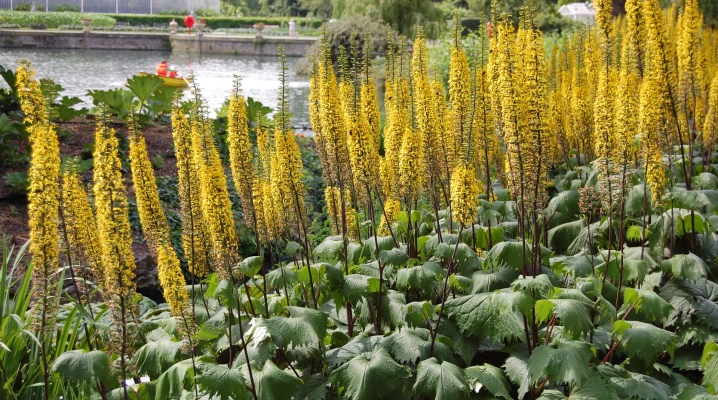
According to experienced gardeners, without a buzulnik, their site would not be attractive and original. And this is not surprising, because the extraordinary foliage and flowers of this plant cannot leave indifferent any lover of interesting vegetation.
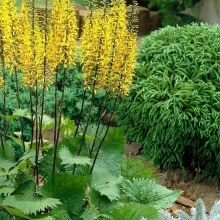


Peculiarities
Buzulnik is an ornamental perennial plant from the Astrov family. Another name for the culture is ligularia. Under natural conditions, this herbaceous plant inhabits eastern, southeastern and central Asia. In nature, buzulnik often inhabits the shores of reservoirs, forest glades, where a humid environment prevails.
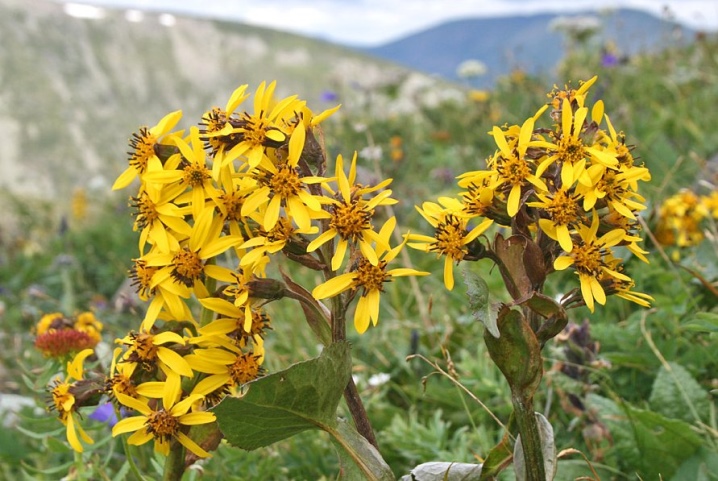
The culture looks pretty unusual. Its description indicates that it consists of a basal rosette with large foliage, which is located on long petioles. The shape of the leaves resembles a triangular carved heart. The color of the leaf blades ranges from dark green to reddish brown. Sometimes there are leaves with a double color, for example, purple and green-violet. Their diameter is usually 0.6 meters.
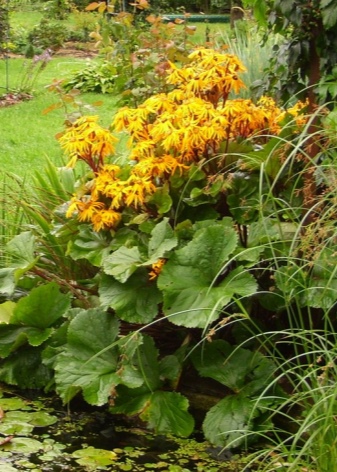

The ligularia flower resembles a basket. It consists of tubular and reed flowers, which do not exceed 10 centimeters in diameter. Blossoming in a buzulnik begins gradually, from below. The inflorescence looks like a panicle, spikelet or brush.
The color of the flowers can be very diverse - from pale yellow to rich orange.
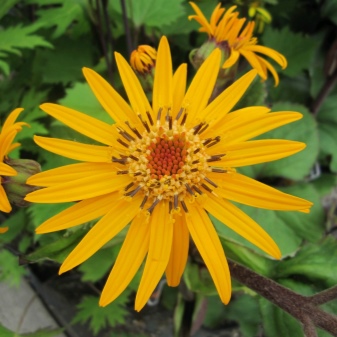
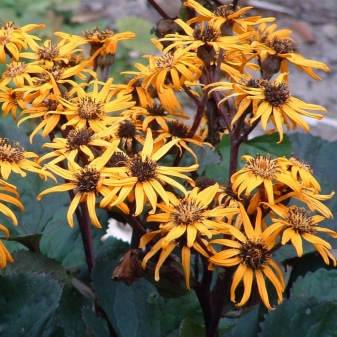
The petiole of the culture is quite large, it reaches 200 centimeters in height. The beginning of flowering of the plant is June, and the end is October. Ligularia is a wonderful honey plant. The ripe fruit looks like a seed with a tuft.
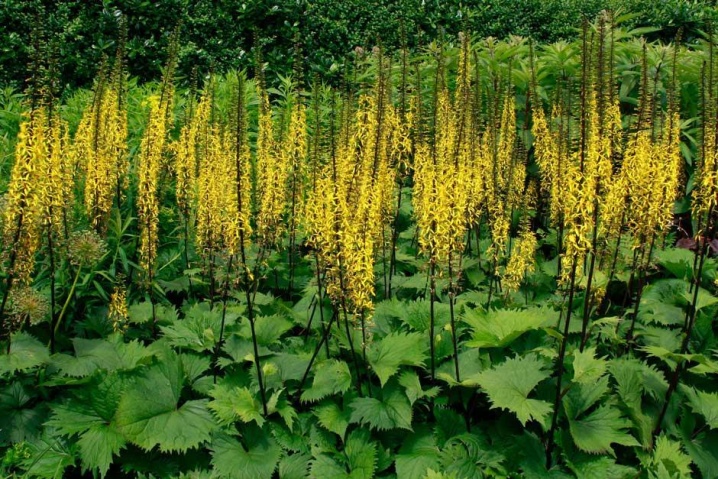
Buzulnik can take root almost throughout the entire territory of Russia, since it belongs to the 4th zone of frost resistance.
Types and varieties
Buzulnik has many varieties. A dwarf, tall or hybrid bush can be with burgundy leaves and ordinary green, while the flowers of the culture can also be of different colors.
The main types of perennials.
- Kempfer. The Japanese variety of culture is characterized by a small branching of the shoots. The foliage is reniform, rather large, it is located near the root system. The leaf plates of the plant are jagged, green in color, and their diameter is 0.25 meters. The bush begins to bloom in the first summer month, at this time golden or light yellow flowers with golden specks appear on it.

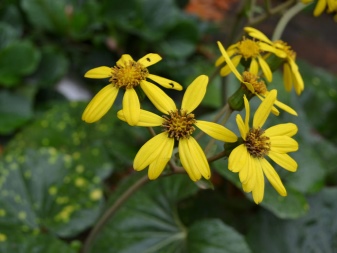
- Przhevalsky - This is an undemanding representative of the flora, which is often used to decorate personal plots. Plant height does not exceed 1.5 meters. The culture has spike-shaped inflorescences, as well as cut leaves, which are very similar to maple leaves. In the last week of June, the culture begins to bloom, and then it looks quite graceful.
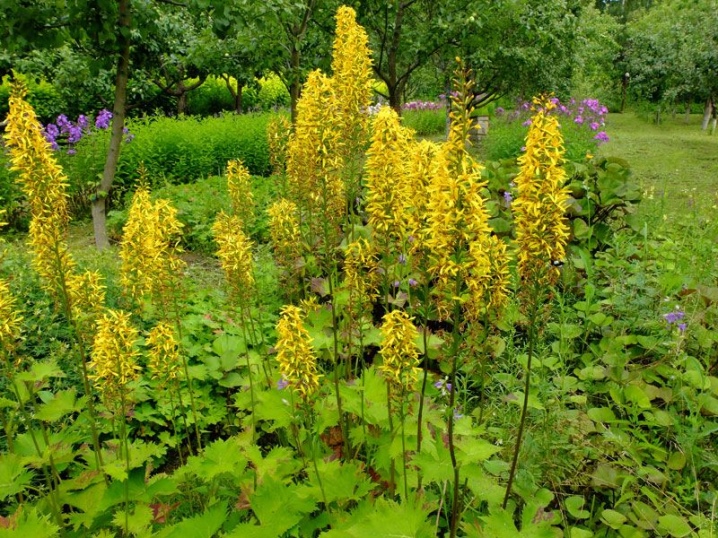
- Serrated. A perennial representative of the flora usually grows up to 1 meter in height. Its leaf plates are rather large and kidney-shaped; they are an integral part of the basal rosette. Baskets of panicle inflorescences have a diameter of 8 centimeters. Reed flowers are pale yellow in color, while tubular flowers are light brown. The flowering of the bush begins in the last summer month.The culture is moderately frost-resistant, but during a harsh winter, it will need additional shelter.
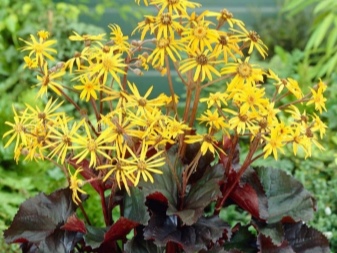

- Large-leaved. Central Asia and the Far East are considered the natural habitat of the ligularia. The lower long-stemmed leaves of the culture can grow up to 45 centimeters in length. The deciduous plates of the plant are characterized by an elliptical shape and a bluish color. In racemose panicles, there are many inflorescences in the form of baskets. The height of the peduncles usually does not exceed 1.5 meters. In winter, this type of buzulnik is not required to be covered.
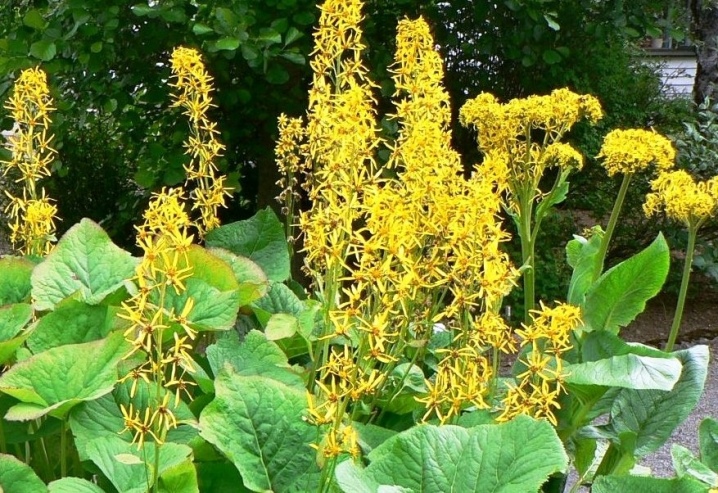
- Wilson. A one and a half meter plant has straight and slightly branched shoots. The leaf blades of the culture are large, they are characterized by a reniform shape and root location. An erect inflorescence usually contains a large number of small yellow baskets. This winter-hardy representative of the flora blooms in early summer.
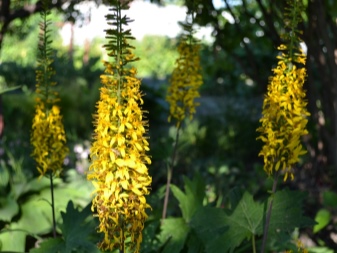
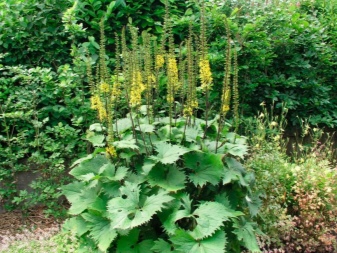
- Siberian. This ligularia belongs to rhizome perennials, its height is usually from 30 to 130 centimeters. In the lower part of the furrowed shoot, there is an elongated heart-shaped foliage. The culture baskets are yellow in color.
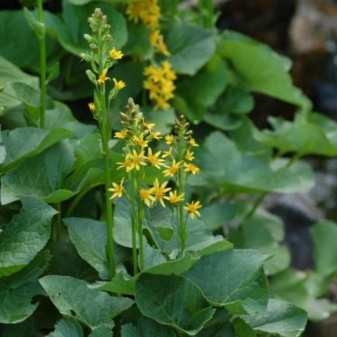
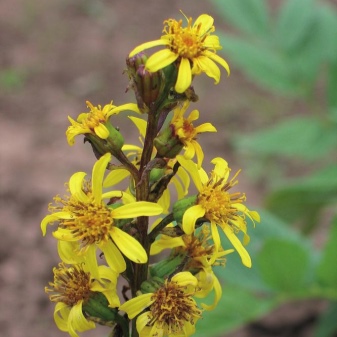
- Narrow-leaved. Ligularia of this species is similar to Przewalski's buzulnik.
The difference of this culture is considered to be larger foliage, as well as the sharp jaggedness of the foliage.
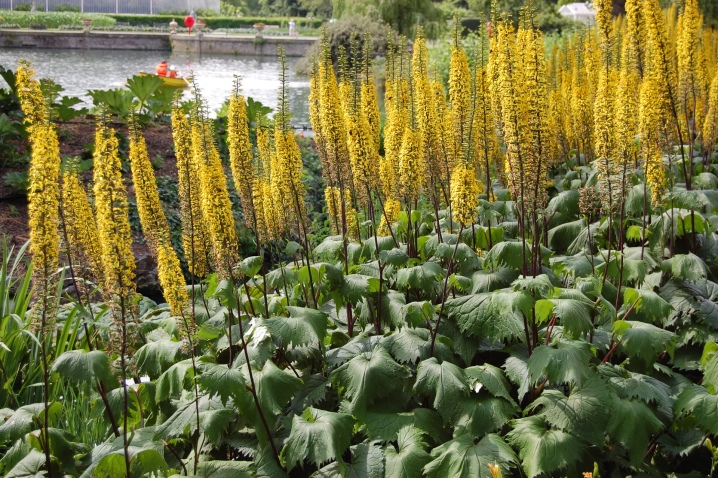
- Fisher. The height of the shrub can vary from 30 to 130 centimeters. The culture has a shortened rhizome and straight furrowed shoots. Rosette foliage can be either heart-shaped or spear-shaped. The petiole of the buzulnik is thin and rather long. In the racemose inflorescence there are 2 to 4 inflorescences. Ligularia blooms with rich yellow flowers around the last week of June.

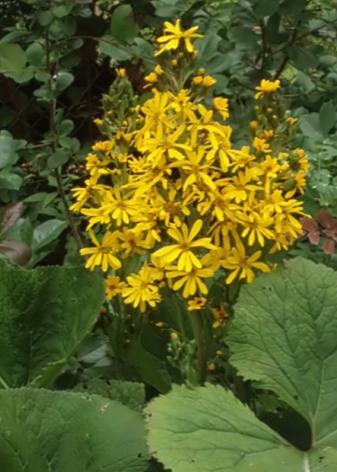
- Hessey - This is a hybrid species of Buzulnik. It was bred on the basis of the serrated variety, it has a direct resemblance to it. The baskets of the plant are very similar to chamomile and are about 5 centimeters in diameter. The ligularia is 2 meters high and a meter wide.
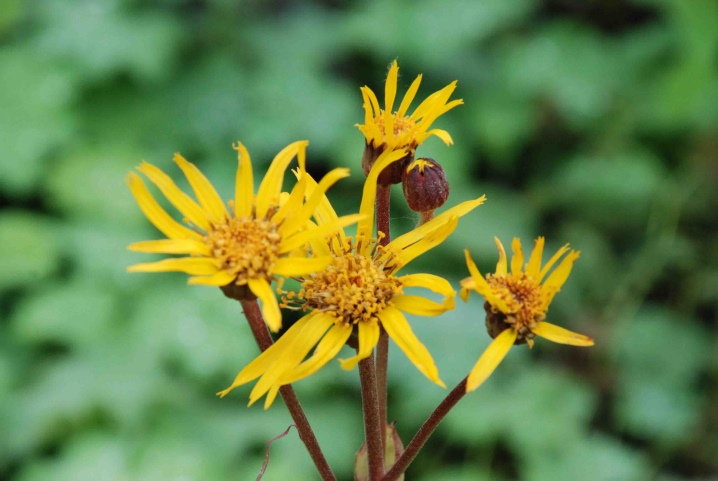
- Tangut Buzulnik - a beautiful plant with a tuberous root system. It reproduces quite easily by dividing the rhizome. Small-leaved shoots, they can grow up to 90 centimeters in height. The foliage has a lace plate, it is characterized by deep dissection and featheriness. Elongated inflorescences have small yellow flowers.
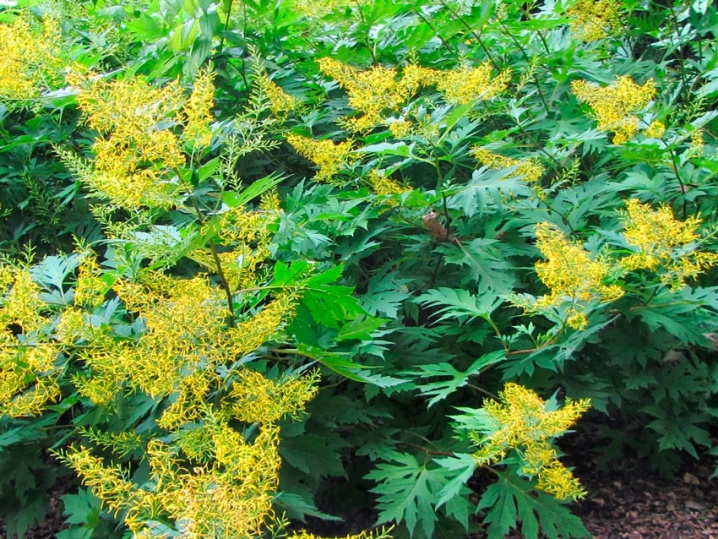
- Vorobyov. Large two-meter bushes have dense leathery leaf plates with a dark green color. The brushes are composed of large baskets.
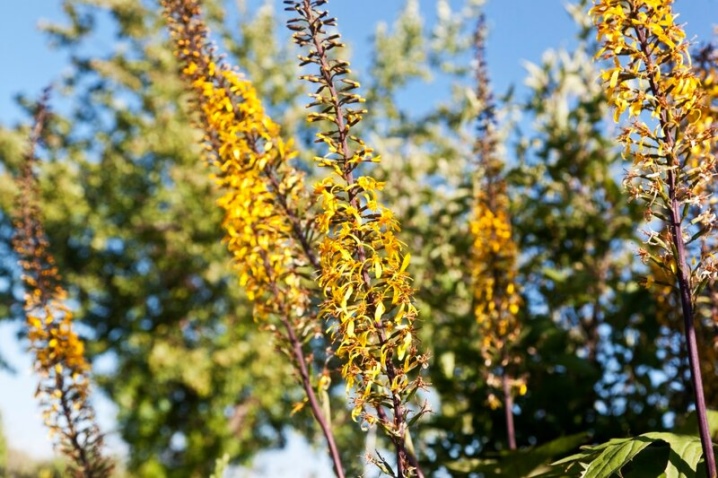
For planting on their site, gardeners often choose the following varieties.
- "Pandora". It is a beautiful crop suitable for a semi-shaded wet area. The plant is characterized by compact size, namely 0.3 meters high and 0.4 meters wide. Pandora's glossy foliage is purple in color, rounded and roughly jagged. Flowers have a shape and color similar to daisies.
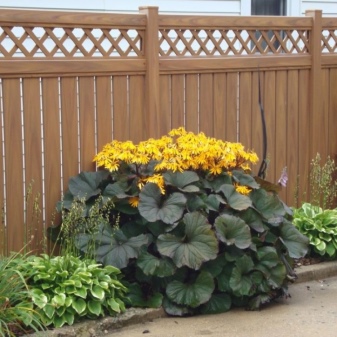
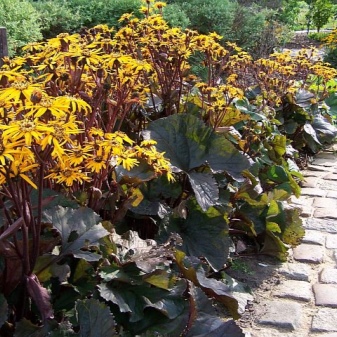
- Britt Marie Crawford - this is one of the most spectacular varieties of ligularia. Its originality lies in its dark foliage and bright yellow flowers.
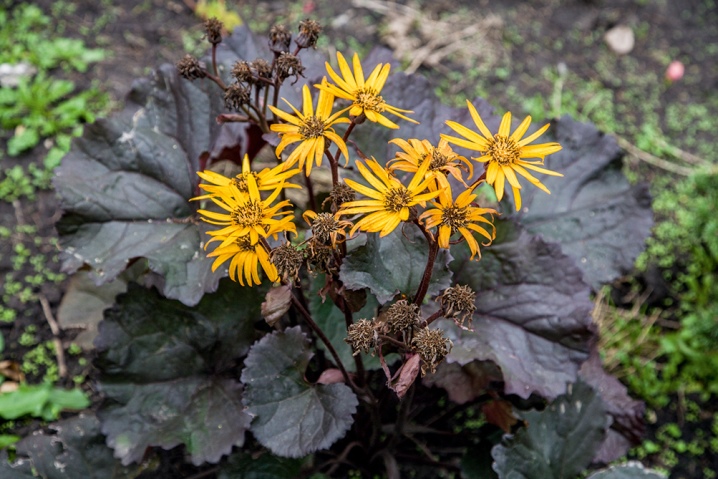
- Bottle Rocket. The height of the culture usually reaches 0.8 meters. This buzulnik variety has dark green leaves and yellow inflorescences, which are twisted on dark-colored petioles.
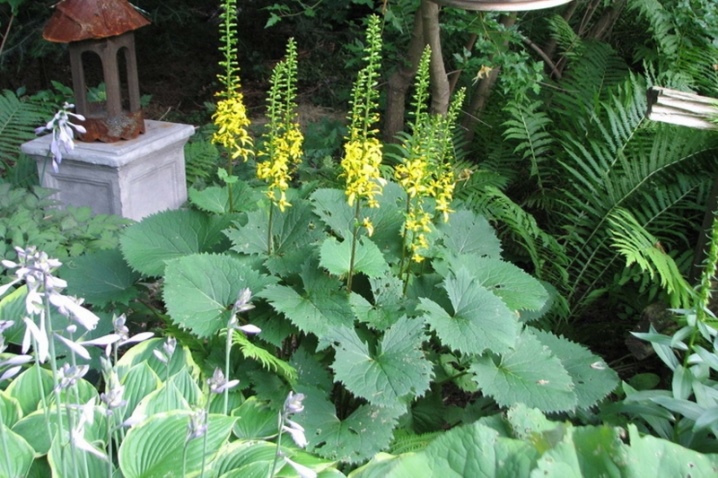
- Osiris Cafe Noir Is a hybrid culture half a meter high. The bush has torn triangular foliage with red veins. The culture loves moisture and partial shade.

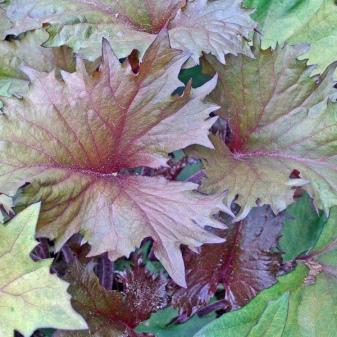
- Little Lantern. The hybrid Buzulnik variety has a rather compact size - its height does not exceed 0.5 meters, and its width is 0.7 meters. The foliage of the culture is dark green heart-shaped.

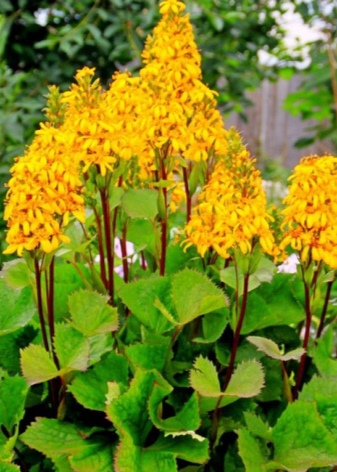
How to plant?
Planting a buzulnik in open ground does not cause difficulties for gardeners. Better to plant the crop in moist, drained soil. - on such a site, the plant will exist for about 20 years.
You should not plant ligularia in a sunny area, the best option in this case will be partial shade.
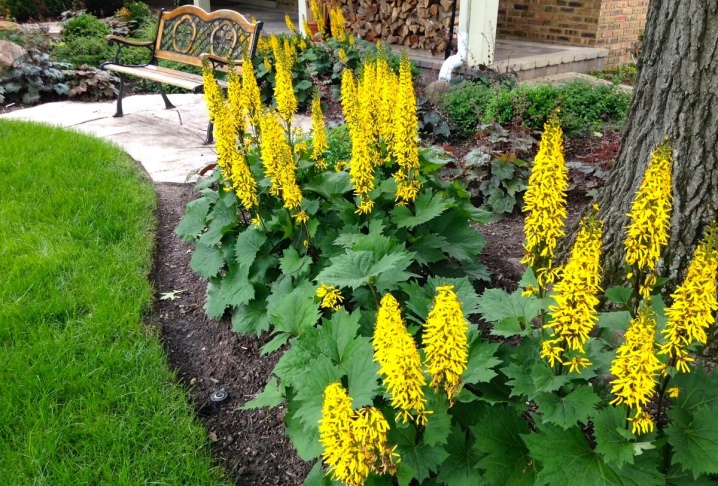
In the case when an adult flowering bush is planted in the summer, advance preparation of the culture will be required. To do this, remove a third of the foliage from the buzulnik, starting from the bottom. A hole must be dug 40 by 40 centimeters in size and filled with a nutritious substrate. For this, humus, superphosphate and wood ash are used. If you want to plant several bushes, you should keep a distance of about 1 meter between them.
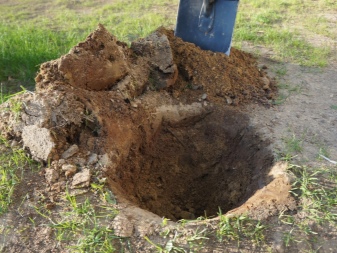
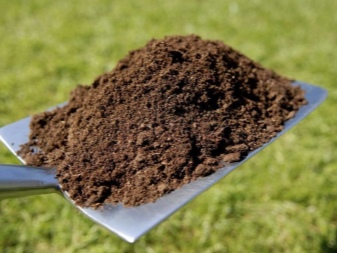
After the root system has been straightened, the plant, placed in the hole, is sprinkled with earth and lightly compacted. Do not forget about watering a young plantation.
How to care?
Despite the unpretentiousness of the culture, she still needs elementary care. If a gardener devotes a little time and energy to a buzulnik, he can count on his originality and beauty.
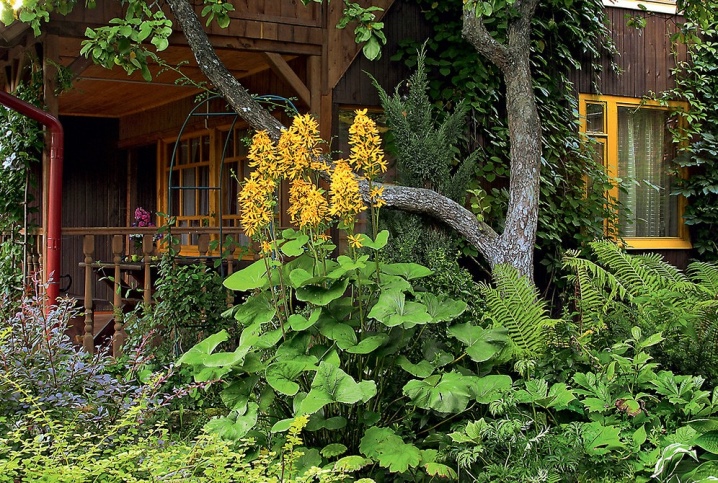
Top dressing
Every 14 days, the buzulnik should be fertilized with dressings for flowering vegetation throughout the growing season. After the perennial has faded, it is required to reduce its fertilization and thereby reduce the percentage of nutrients in the soil.
In winter, the plant should not be fed, since it is dormant.
It is necessary to resume fertilizing in the spring, when young foliage appears. It should be remembered that the fertilizer should contain a lot of nitrogen, as it contributes to the rapid formation of green mass. It is necessary to apply mineral fertilizers to a well-moistened soil, after abundant irrigation.
Buzulnik responds well to mineral and organic fertilizing, for example, humus, rotted horse or cow manure. For efficiency, it is recommended to alternate between different types of fertilizers.
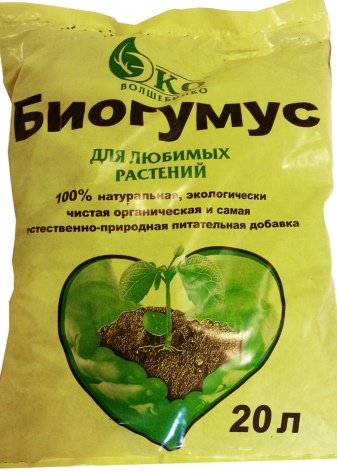
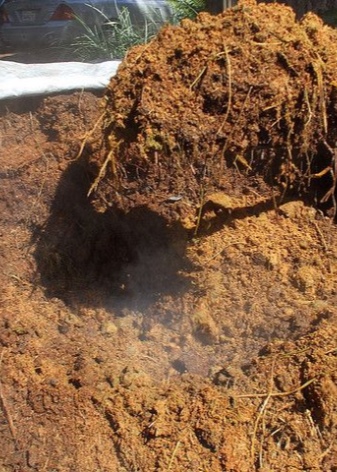
Watering
Irrigation of the ligularia should be abundant, especially during the growing season. The soil must be constantly moistened. At the same time, do not overmoisten the soil during the period of bud formation and during the phase of active growth. Buzulnik badly treats overdried substrate. For irrigation, it is worth using settled water at room temperature.
In the warm season, this representative of the flora is shown a shower with a water temperature of about 35 degrees Celsius. After the procedure, it is recommended to leave the plant alone so that it can enjoy its condition. By autumn, the frequency of irrigation should be reduced, and in winter it is worth observing the moisture content of the soil. You can resume the previous irrigation schedule when the crop shows signs of new growth.
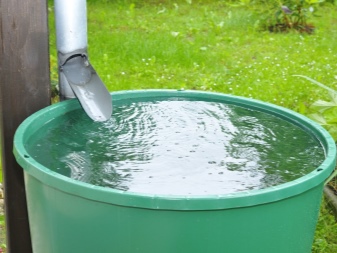
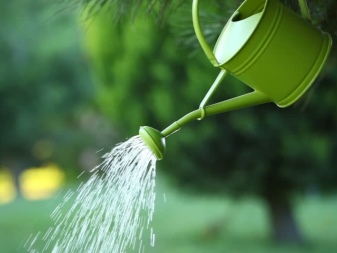
Transfer
Ligularia transplant should be done in the spring. If the bush is young, then the procedure is worth carrying out every year. For planting, it is worth preparing roomy containers that have large drainage holes, since the buzulnik has large roots. Every year, the culture pot should be selected 4-5 centimeters more than before.

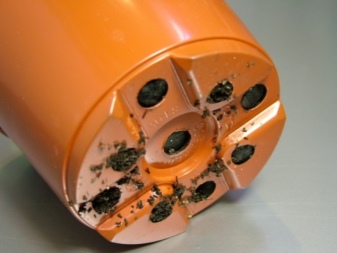
It is best to transplant a perennial before flower stalks form on it and flowering begins.
During and after flowering
Buzulnik is a large perennial, therefore, during the blooming of the buds, the petioles should be fixed in such a way that the flowers are in an upright position. Gardeners should remember that special care is required at the end of the flowering of the ligularia. After flowering, it is imperative to cut off the stems. This procedure promotes the growth of foliage until the fall.
Pruning and garter
Buzulnik is an unpretentious perennial, whose health will be helped by elementary agrotechnical measures. From time to time, the culture dies off old foliage. It must be removed with a pruner from the very base so that the bush looks attractive. TIt is also worthwhile to promptly eliminate peduncles with a withering bud, provided that seeds are not needed for subsequent sowing.
Sometimes ligularia forms a high peduncle, which requires support and tying to it.
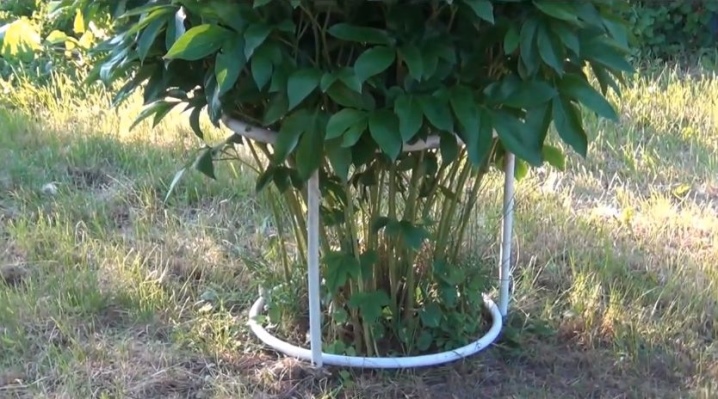
Preparing for winter
After the first frosts begin, the gardener should cut off the part of the plant that is above the earth's surface. At the end of the procedure, it is worth mulching the territory in which the culture is planted. Despite the frost resistance of ligularia, with the onset of severe frosts or the absence of snow, the plant may die. Therefore, in addition to the above activities, it is recommended to build a shelter for the buzulnik.
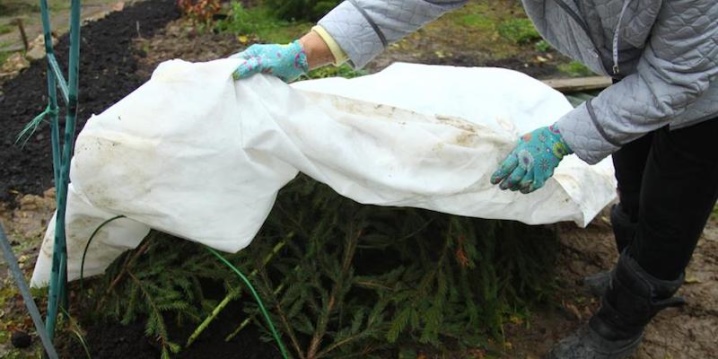
Reproduction methods
To propagate a buzulnik, it is worth adhering to some rules. This procedure can be carried out in the following ways.
- Bush division. It means dividing one plant into several parts. The roots of the buzulnik are divided with a knife or shovel, after which they dig out the cut. The remaining space should be filled with soil. Ligularia should be planted by treating its roots with a growth stimulant. After the measures taken, the perennial takes root well.
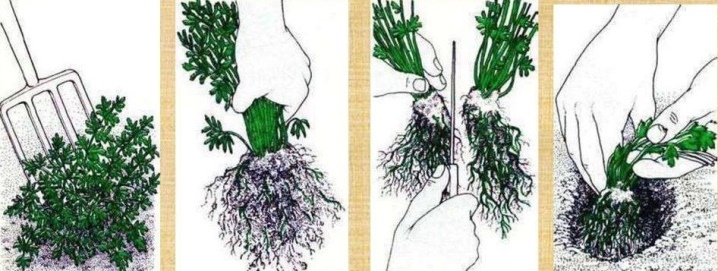
- Seeds. The collection of planting material should be carried out in the autumn. Germination of seeds is carried out in a standard way, after which the sprouts should be planted in separate containers in which the prepared or purchased substrate is located. In spring, seedlings must be planted in open ground, where they can be grown in the future.
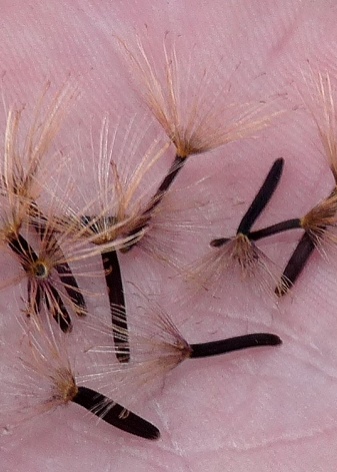

- Cuttings. This breeding option is considered the most difficult, since it is worth selecting shoots for it that have from 3 to 4 buds. After cutting, the cuttings are treated with a growth stimulant by immersing the culture in liquid or soil. The best option is to immerse the cutting in water, since you can observe the growth of its root system. After it gets stronger, the plant can be planted on the site.
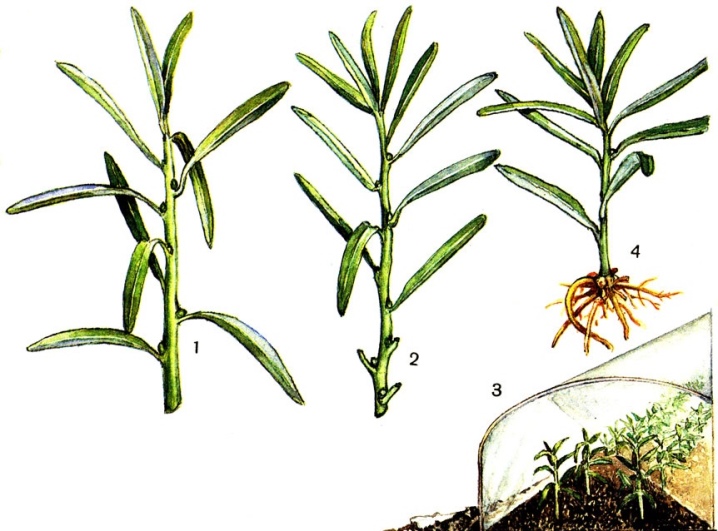
If the culture was planted in the soil, then it should be abundantly irrigated for several days. When dividing a bush, it is worth giving preference to the section on which there are shoots with buds.
Diseases and pests
Ligularia is the type of plant that is practically immune to diseases and parasites. However, the dangers that can ruin the culture do exist. A dangerous pest of buzulnik is considered slug... It eats young leaves and stems of the crop. To eliminate it, it is recommended to sprinkle the area with a broken nutshell or superphosphate in the form of granules. Mealybug and snail Ligularia also liked the taste. The fight against them is similar to the previous one.
Can harm a perennial powdery mildew... Treatment of this disease is possible by spraying the shrub with a 1% solution of colloidal sulfur. A solution based on soap and mustard powder can also help get rid of powdery mildew. Direct sunlight can cause burns to foliage.
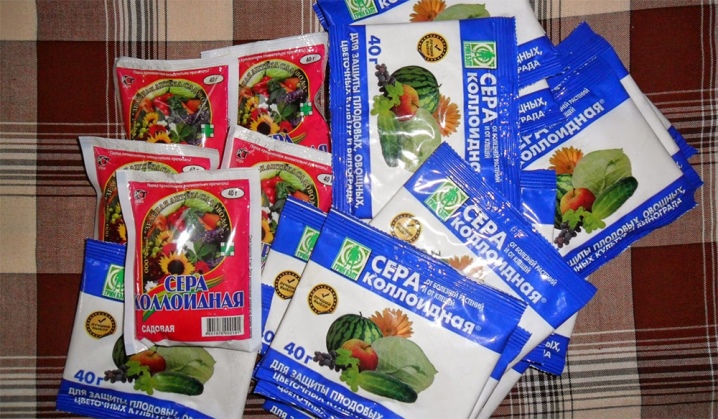
Use in landscape design
Ligularia is often planted in the garden, in a flower bed; landscape designers use it in their work because of its unpretentiousness and spectacular appearance. In the flower garden, the shrub goes well with many other plants. It can become a bright spot against the backdrop of greenery.
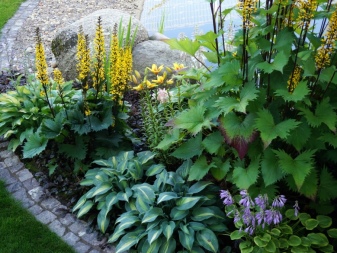
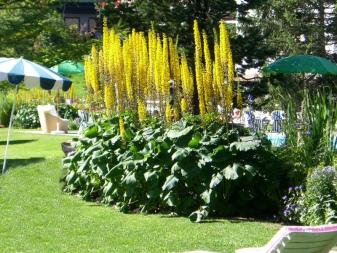
When decorating a territory, the following options for using a buzulnik can be distinguished:
- as a ground cover plant for continuous coverage of the territory with greenery;
- as a decoration for the background of flower beds.
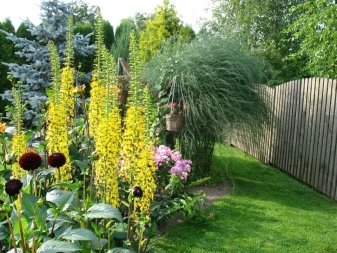

The crop is often planted singly or in groups along the edge of a pond, garden path, or near a building. Ligularia will be the center of the flower bed if many flowers are planted around it. From this representative of the flora, you can form a wall that will hide the flaws of the fence or fence.
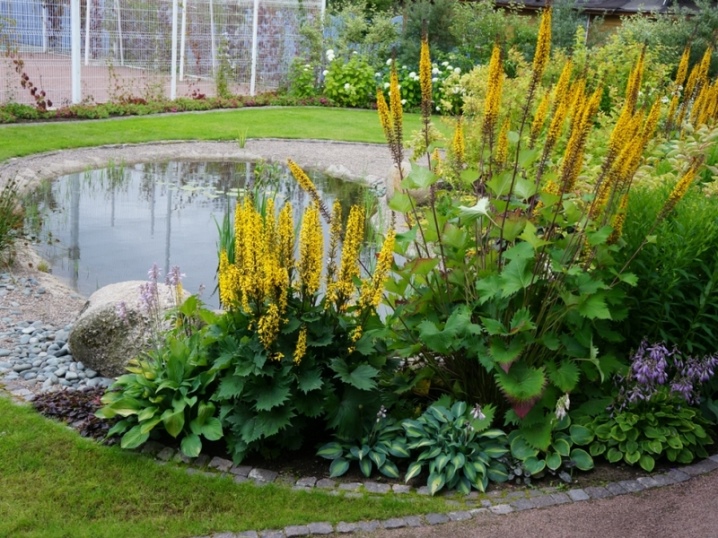
Buzulnik looks great in the background of the mixborder. This plant goes well with fern, iris, heuchera. Ligularia can be a worthy choice for gardeners who want to decorate their territory with an unpretentious and bright perennial.

In the same place, the culture can grow for about 10 years.Since a large number of varieties of this culture are currently known, each of the gardeners can choose the variety they like.
All about the buzulnik, see the video.







































































































The comment was sent successfully.